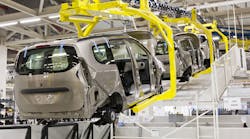According to Statista, the global automotive industry will grow to about $9 trillion by 2030, with new vehicle sales accounting for about a 38% slice of that pie. Although the global COVID-19 pandemic may have impacted certain sectors over the past few months, Frost & Sullivan notes that a decline in car sales typically last only two years, rallying to pre-recession levels within four years, based on data from the last 50 years.
Indeed, the automotive space is an exciting place to be, yet ongoing industry and technology disruption can be challenging. Moving large parts across the factory floor, unforeseen safety incidents, and inconsistent transport systems often slow down production and cause loss of production efficiency.
However, what if a factory could better meet these evolving demands? What does it take to digitize automotive manufacturing production processes to better control output quality and quantity? What does a true smart factory look like and how does it work at-scale?
The Promise of Digital Transformation
Half of automotive manufacturers say that to maintain operations by 2030, they must enhance their organizations with digital technologies. Considering this broad industry recognition of the need to pursue digital-transformation efforts, traditional automotive manufacturers are working to digitize antiquated manual monitoring systems in their assembly process.
Over the past 50 years, the automotive industry has collectively invested billions of dollars in enterprise systems, automation solutions, and advanced product technologies. As a next step, automotive companies must embrace the advantages provided by data and technology-forward companies that are redefining manufacturing processes and enabling other industries with Industry 4.0 capabilities. In addition, digitization initiatives must be measured and validated regularly for automakers to clearly see the true value of their efforts.
Identifying the Highest-Value Use Cases
To realize the most compelling business outcomes for potential digital-transformation initiatives, automakers must first identify and prioritize which use cases are most critical to overall success and will deliver the highest ROI. Realizing the value of digital-transformation investments before they begin—by identifying specific use cases and the associated ROIs—manufacturers will be able to weigh the cost vs. benefit of their digital-transformation initiatives and pursue them to fruition.
There are four main high-value use cases for digital transformation in the automotive industry: scalable production management, asset optimization, real-time operational intelligence, and digital workforce productivity.
Integration between operational technology (OT) and information technology (IT) is critical to realizing and executing the initiatives that must be undertaken to achieve those four use cases, which ultimately lead to productivity gains at scale. When OT and IT are integrated, automakers possess an improved understanding of factory operations, often resulting in a significant reduction in machine downtime, improved yield, and other various benefits.
When it comes to quality control and manufacturing optimization, the industrial Internet of Things (IIoT) is an excellent example of the integration of OT and IT. IIoT enables automakers to not only monitor production for hiccups and faults, but also drive growth of the enterprise thanks to greater access to data. IIoT sensors, placed strategically on machines and workstations across the shop floor, analyze bottlenecks, provide data to support predictive maintenance suggestions, and reassign workstation tasks in more efficient ways, as well as improve quality and safety issues.
By using scalable analytics, automakers can process the vast amounts of shop-floor data provided by IIoT sensors to fully optimize the entire production line. For example, vehicle parts may travel through multiple facilities before being fully assembled. OT/IT integration allows automotive production managers to maintain complete visibility of each part’s assembly journey through the supply chain. Data from shop-floor equipment, provided by IIoT sensors, can be analyzed to predict how any changes will impact overall production and quality control.
Previously, much of the data used to validate digital-transformation initiatives, such as OT/IT integration and IIoT, can only be collected once those initiatives are fulfilled. Fortunately, thanks to new digital technologies, including augmented reality (AR) and digital twins, automakers can test prospective new systems in a virtual environment before dedicating resources and deploying them in the real world.
Once Automakers Identify Specific Use Cases and ROI, What’s Next?
Full-stack IIoT solution providers can design and support an automaker’s entire IIoT ecosystem from shop-floor machines to top-floor control systems to cloud-computing capabilities. If an automaker is unsure of where to begin their digital transformation journey or how to weigh the costs versus the benefits of digitization initiatives, they should partner with such an experienced provider to better understand their path to Industry 4.0.
A full-stack solution provider enables the critical deployment of digital-transformation projects at scale and ensures the relevance of those projects over time. IoT solution providers not only make the initial deployment of digital-transformation efforts easier, but also enable automakers to further adopt innovative new technologies, such as edge computing, AR, and digital twins. Unlike consumer IoT, which has a short lifespan of just a few years, IIoT must be tailored to match the unique needs of a specific enterprise to ensure it can stand the test of time.
In selecting a solution provider, be sure to not only engage a partner with extensive technical expertise, but one that also fully understands the unique needs of the automotive industry. This ensures that they can adequately tailor IIoT initiatives to meet long-term goals.
The key to measuring IIoT success is knowing exactly where the path to digital transformation begins and where it will lead. Organization should fully understand the benefits provided by scalable IIoT when it comes to enabling enterprises with Industry 4.0 capabilities needed to remain competitive. With this, automakers can accurately weigh the cost versus benefits of their digitization initiatives and see them through to fruition. Often, the benefits of delivering increased value to consumers today in the form of higher-quality-control standards and ensuring strategic competitive advantages in future production outweigh the costs.
Keith Higgins is VP of Digital Transformation at Rockwell Automation.
